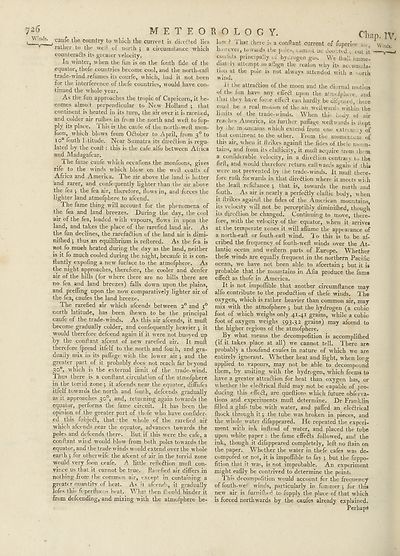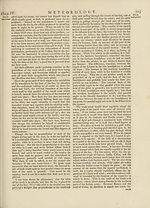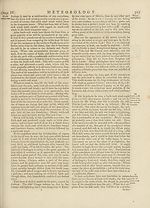Encyclopaedia Britannica, or, a Dictionary of arts, sciences, and miscellaneous literature : enlarged and improved. Illustrated with nearly six hundred engravings > Volume 13, MAT-MIC
(772) Page 726
Download files
Complete book:
Individual page:
Thumbnail gallery: Grid view | List view

726
Winds.
M E T E O
^ cauie the country to winch the current is dirt-died lies
rather to the welt of north 5 a ciicumdance which
countera&s its greater velocity.
In winter, when the fun is on the fouth fide of the
equator, thefe countries become cool, and the north-call
trade-wind refumes its courfe, which, had it not been
for the interference of thefe countries, would have con¬
tinued the whole year.
As the fun approaches the tropic of Capricorn, it be¬
comes almo t perpendicular to New Holland ; that
continent is heated 111 its turn, the air over it is rareiied,
and colder air rallies in from the north and well to fup-
ply its place. 1 his is the cauie of the north-weft mon-
foon, which blows from Odlober to April, from 30 to
lO° fouth 1 titude. Near Sumatra its diredlion is regu¬
lated by the coalt ; this is the cafe alfo between Africa
and Madagafcar.
I he fame caufe which occafions the monfoons, gives
rife to the winds which blow on the weft coafts of
Africa and America. The air above the land is hotter
and rarer, and confequently lighter than the air above
the fea j the fea air, therefore, Hows in, and forces the
lighter land atmofphere to afcend.
I he fame thing will account for the phenomena of
the fea and land breezes. During the day, the cool
air of the fea, loaded writh vapours, flows in upon the
land, and takes the place of the rarefied land air. As
the fun declines, the rarefadlion of the land air is dimi-
nifhed j thus an equilibrium is reftored. As the fea is
not fo much heated during the day as the land, neither
is it fo much cooled during the night, becaufe it is con-
ftantly expofing a new furface to the atmofphere. As
the night approaches, therefore, the cooler and denfer
air of the hills (for w here there are no hills there are
no fea and land breezes) falls down upon the plains,
and prefling upon the now comparatively lighter air of
the fea, caufes the land breeze.
I he rarefied air which afcends between 2° and j°
north latitude, has been ftiewm to be the principal
caufe of the trade-winds. As this air afcends, it muft
become gradually colder, and confequently heavier ; it
would therefore defcend again if it were not buoyed up
h>y the conftant afcent of new rarefied air. It muft
therefore fpread itfelf to the north and foul h, and gra¬
dually mix in its paffage w ith the lower air ; and the
greater part of it probably does not reach far beyond
go0, which is the external limit of the trade-wind.
Thus there is a conftant circulation of the atmofphere
in the torrid zone ; it afcends near the equator, diffufes
itfelf towards the north and iouth, defcends gradually
as it approaches 30°, and, returning again towards the
equator, performs the fame circuit. It has been the
opinion of the greater part of thofe who have eonfider-
ed this fubjedf, that the whole of the rarefied air
which afcends near the equator, advances towards the
poles and defcends there. But if this were the cafe, a
conftant wind would blow from both poles towards the
equator, and the trade wind'- would extend over the whole
earth ; for otherw'ife the afcent of air in the torrid zone
would very foon ceafe. A little refledlion muft con¬
vince us that it cannot be true. Rarefied air differs in
nothing from the common air, except in containing a
greater nuantit-y of heat. As it aft ends, it gradually
lofes this fuperfluous heat. What then 1! ould hinder it
from defcending, and mixing with the atmolphere be-
H O L O G Y. Chap, IV,
low ? That there i- a conftant current of fuperior an, Winds,
however, towards ihe poles, cannot uc doubted ; out it •—
coulhts principally oi hydrogen gas. Wc lhali imme-
diat ly attempt to aftign the realon why its accumula¬
tion at the pole is not always attended with a north
wind.
it the attraction of the moon and the diurnal motion
of the fun have any efieft upon the atmofphere and
tnat they have fome effect can hardly be dil uted, there
muft be j real motion of the aii weft ward , within the
limits of the trade-winds. When this body of air
reaches America, its further paffage weft wards is iiopt.
by ;he mountains which extend from one extremuy of
that continent to the other. From the momentum of
this air, w hen it ftrikes againft the fides of theie moun¬
tains, and from its elafticity, it muft acquire from ih. m
a confiderable velocity, in a diredion contrary to the
firft, and would therefore return call wards again if this
were not prevented by the trade-winds. It muft there¬
fore ruih forwards in that diredion where it meets vvhh
the leaft refiftance ; that is, towards the north and
fouth. As air is nearly a perfedly elaftic body, when
it ftrikes againft the fides of the American mountains,
its velocity will not be perceptibly diminifhed, though
its diredion be changed. Continuing to move, there¬
fore, with the velocity of the equator, when it arrive*
at the temperate zones it will affume the appearance of
a north-eaft or fouth-eaft wind. To this is to be af-
cribed the frequency of fouth-weft winds over the At¬
lantic ocean and weftern parts of Europe. Whether
thefe winds are equally frequent in the northern Pacific
ocean, we have not been able to afeertain ; but it is
probable that the mountains in Alia produce the fame
effed as thofe in America.
It is not impoflible that another circumftance may
alfo contribute to the produdion of thefe winds. The
oxygen, which is rather heavier than common air, may-
mix with the atmofphere j but the hydrogen (a cubic
foot of which weighs only 41.41 grains, while a cubic
foot of oxygen, weighs 593.32 grains) may afcend to
the higher regions of the atmofphere.
By what means the decompofition is accomplilhed
(if it takes place at all) we cannot tell. There are
probably a thoufand caufes in nature of which we are
entirely ignorant. Whether heat and light, when long
applied to vapours, may not be able to decompound
them, by uniting with the hydrogen, which feems to
have a greater attradion for heat than oxygen has, or
whether the eledrical fluid may not be capable of pro¬
ducing this effed:, are queftions which future obferva-
tions and experiments muft determine. Dr Franklin
filled a glaf- tube with water, and paffed an eledrical
ftioek through it 5 the tube was broken in pieces, and
the whole water difappeared. He repeated the experi¬
ment with ink inftead of water, and placed the tube
upon white paper : the fame effeds followed, and the
ink, though it difappeared completely, left no ftain on
the paper. Whether the water in thefe cafes wras de-
compofed or not, it is impoflible to fay ; but the fuppo-
fition that it wras, is not improbable. An experiment
might eafily be contrived to determine the point.
This decompofition would account for the freouency
of fouth-wei winds, particularly in fummer ; for this
new' air is furniftied to fupply "the place of that which
is forced northwards by the caufes already explained.
Perhaps
Winds.
M E T E O
^ cauie the country to winch the current is dirt-died lies
rather to the welt of north 5 a ciicumdance which
countera&s its greater velocity.
In winter, when the fun is on the fouth fide of the
equator, thefe countries become cool, and the north-call
trade-wind refumes its courfe, which, had it not been
for the interference of thefe countries, would have con¬
tinued the whole year.
As the fun approaches the tropic of Capricorn, it be¬
comes almo t perpendicular to New Holland ; that
continent is heated 111 its turn, the air over it is rareiied,
and colder air rallies in from the north and well to fup-
ply its place. 1 his is the cauie of the north-weft mon-
foon, which blows from Odlober to April, from 30 to
lO° fouth 1 titude. Near Sumatra its diredlion is regu¬
lated by the coalt ; this is the cafe alfo between Africa
and Madagafcar.
I he fame caufe which occafions the monfoons, gives
rife to the winds which blow on the weft coafts of
Africa and America. The air above the land is hotter
and rarer, and confequently lighter than the air above
the fea j the fea air, therefore, Hows in, and forces the
lighter land atmofphere to afcend.
I he fame thing will account for the phenomena of
the fea and land breezes. During the day, the cool
air of the fea, loaded writh vapours, flows in upon the
land, and takes the place of the rarefied land air. As
the fun declines, the rarefadlion of the land air is dimi-
nifhed j thus an equilibrium is reftored. As the fea is
not fo much heated during the day as the land, neither
is it fo much cooled during the night, becaufe it is con-
ftantly expofing a new furface to the atmofphere. As
the night approaches, therefore, the cooler and denfer
air of the hills (for w here there are no hills there are
no fea and land breezes) falls down upon the plains,
and prefling upon the now comparatively lighter air of
the fea, caufes the land breeze.
I he rarefied air which afcends between 2° and j°
north latitude, has been ftiewm to be the principal
caufe of the trade-winds. As this air afcends, it muft
become gradually colder, and confequently heavier ; it
would therefore defcend again if it were not buoyed up
h>y the conftant afcent of new rarefied air. It muft
therefore fpread itfelf to the north and foul h, and gra¬
dually mix in its paffage w ith the lower air ; and the
greater part of it probably does not reach far beyond
go0, which is the external limit of the trade-wind.
Thus there is a conftant circulation of the atmofphere
in the torrid zone ; it afcends near the equator, diffufes
itfelf towards the north and iouth, defcends gradually
as it approaches 30°, and, returning again towards the
equator, performs the fame circuit. It has been the
opinion of the greater part of thofe who have eonfider-
ed this fubjedf, that the whole of the rarefied air
which afcends near the equator, advances towards the
poles and defcends there. But if this were the cafe, a
conftant wind would blow from both poles towards the
equator, and the trade wind'- would extend over the whole
earth ; for otherw'ife the afcent of air in the torrid zone
would very foon ceafe. A little refledlion muft con¬
vince us that it cannot be true. Rarefied air differs in
nothing from the common air, except in containing a
greater nuantit-y of heat. As it aft ends, it gradually
lofes this fuperfluous heat. What then 1! ould hinder it
from defcending, and mixing with the atmolphere be-
H O L O G Y. Chap, IV,
low ? That there i- a conftant current of fuperior an, Winds,
however, towards ihe poles, cannot uc doubted ; out it •—
coulhts principally oi hydrogen gas. Wc lhali imme-
diat ly attempt to aftign the realon why its accumula¬
tion at the pole is not always attended with a north
wind.
it the attraction of the moon and the diurnal motion
of the fun have any efieft upon the atmofphere and
tnat they have fome effect can hardly be dil uted, there
muft be j real motion of the aii weft ward , within the
limits of the trade-winds. When this body of air
reaches America, its further paffage weft wards is iiopt.
by ;he mountains which extend from one extremuy of
that continent to the other. From the momentum of
this air, w hen it ftrikes againft the fides of theie moun¬
tains, and from its elafticity, it muft acquire from ih. m
a confiderable velocity, in a diredion contrary to the
firft, and would therefore return call wards again if this
were not prevented by the trade-winds. It muft there¬
fore ruih forwards in that diredion where it meets vvhh
the leaft refiftance ; that is, towards the north and
fouth. As air is nearly a perfedly elaftic body, when
it ftrikes againft the fides of the American mountains,
its velocity will not be perceptibly diminifhed, though
its diredion be changed. Continuing to move, there¬
fore, with the velocity of the equator, when it arrive*
at the temperate zones it will affume the appearance of
a north-eaft or fouth-eaft wind. To this is to be af-
cribed the frequency of fouth-weft winds over the At¬
lantic ocean and weftern parts of Europe. Whether
thefe winds are equally frequent in the northern Pacific
ocean, we have not been able to afeertain ; but it is
probable that the mountains in Alia produce the fame
effed as thofe in America.
It is not impoflible that another circumftance may
alfo contribute to the produdion of thefe winds. The
oxygen, which is rather heavier than common air, may-
mix with the atmofphere j but the hydrogen (a cubic
foot of which weighs only 41.41 grains, while a cubic
foot of oxygen, weighs 593.32 grains) may afcend to
the higher regions of the atmofphere.
By what means the decompofition is accomplilhed
(if it takes place at all) we cannot tell. There are
probably a thoufand caufes in nature of which we are
entirely ignorant. Whether heat and light, when long
applied to vapours, may not be able to decompound
them, by uniting with the hydrogen, which feems to
have a greater attradion for heat than oxygen has, or
whether the eledrical fluid may not be capable of pro¬
ducing this effed:, are queftions which future obferva-
tions and experiments muft determine. Dr Franklin
filled a glaf- tube with water, and paffed an eledrical
ftioek through it 5 the tube was broken in pieces, and
the whole water difappeared. He repeated the experi¬
ment with ink inftead of water, and placed the tube
upon white paper : the fame effeds followed, and the
ink, though it difappeared completely, left no ftain on
the paper. Whether the water in thefe cafes wras de-
compofed or not, it is impoflible to fay ; but the fuppo-
fition that it wras, is not improbable. An experiment
might eafily be contrived to determine the point.
This decompofition would account for the freouency
of fouth-wei winds, particularly in fummer ; for this
new' air is furniftied to fupply "the place of that which
is forced northwards by the caufes already explained.
Perhaps
Set display mode to:
![]() Universal Viewer |
Universal Viewer | ![]() Mirador |
Large image | Transcription
Mirador |
Large image | Transcription
Images and transcriptions on this page, including medium image downloads, may be used under the Creative Commons Attribution 4.0 International Licence unless otherwise stated. ![]()
| Permanent URL | https://digital.nls.uk/192694086 |
|---|
| Attribution and copyright: |
|
|---|
| Description | Ten editions of 'Encyclopaedia Britannica', issued from 1768-1903, in 231 volumes. Originally issued in 100 weekly parts (3 volumes) between 1768 and 1771 by publishers: Colin Macfarquhar and Andrew Bell (Edinburgh); editor: William Smellie: engraver: Andrew Bell. Expanded editions in the 19th century featured more volumes and contributions from leading experts in their fields. Managed and published in Edinburgh up to the 9th edition (25 volumes, from 1875-1889); the 10th edition (1902-1903) re-issued the 9th edition, with 11 supplementary volumes. |
|---|---|
| Additional NLS resources: |
|

